
A firearm is any type of gun that uses an explosive charge and is designed to be readily carried and operated by an individual. The term is legally defined further in different countries.

In firearm designs, the term single-shot refers to guns that can hold only a single round of ammunition inside and thus must be reloaded manually after every shot. Compared to multi-shot repeating firearms ("repeaters"), single-shot designs have no moving parts other than the trigger, hammer/firing pin or frizzen, and therefore do not need a sizable receiver behind the barrel to accommodate a moving action, making them far less complex and more robust than revolvers or magazine/belt-fed firearms, but also with much slower rates of fire.

The percussion cap, percussion primer, or caplock, introduced in the early 1820s, is a type of single-use percussion ignition device for muzzle loader firearm locks enabling them to fire reliably in any weather condition. Its invention gave rise to the caplock mechanism or percussion lock system which used percussion caps struck by the hammer to set off the gunpowder charge in rifles and cap and ball firearms. Any firearm using a caplock mechanism is a percussion gun. Any long gun with a cap-lock mechanism and rifled barrel is a percussion rifle. Cap and ball describes cap-lock firearms discharging a single bore-diameter spherical bullet with each shot.

A cartridge, also known as a round, is a type of pre-assembled firearm ammunition packaging a projectile, a propellant substance and an ignition device (primer) within a metallic, paper, or plastic case that is precisely made to fit within the barrel chamber of a breechloading gun, for convenient transportation and handling during shooting. Although in popular usage the term "bullet" is often used to refer to a complete cartridge, the correct usage only refers to the projectile.

In firearms terminology, an action is the functional mechanism of a breech-loading firearm that handles the ammunition cartridges, or the method by which that mechanism works. Actions are technically not present on muzzleloaders, as all those are single-shot firearms with a closed off breech with the powder and projectile manually loaded from the muzzle. Instead, the muzzleloader ignition mechanism is referred to as the lock.

The Colt AR-15 is a lightweight, magazine-fed, gas-operated, autoloading rifle manufactured by Colt's Manufacturing Company ("Colt"). The rifle is a derivative of its predecessor, the ArmaLite AR-15, an automatic rifle designed by Eugene Stoner and other engineers at ArmaLite in 1956.
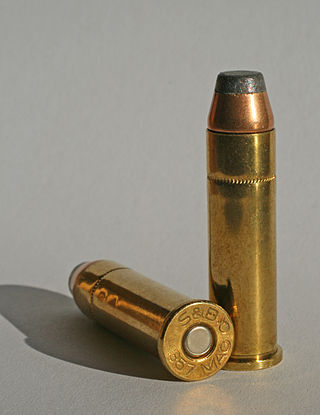
A centre-fire is a type of metallic cartridge used in firearms, where the primer is located at the center of the base of its casing. Unlike rimfire cartridges, the centerfire primer is typically a separate component seated into a recessed cavity in the case head and is replaceable by reloading the cartridge.
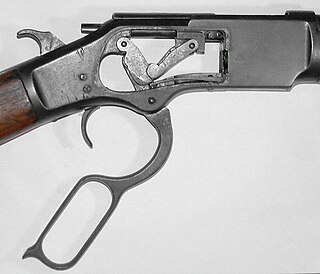
A lever action is a type of action for repeating firearms that uses a manually operated cocking handle located around the trigger guard area that pivots forward to move the bolt via internal linkages, which will feed and extract cartridges into and out of the chamber, and cock the firing pin mechanism. This contrasts to other type of repeating actions such as the bolt-action, pump-action, semi-automatic, fully automatic, and/or burst mode actions. A firearm using this operating mechanism is colloquially referred to as a levergun.

Electronic firing refers to the use of an electric current to fire a cartridge instead of a centerfire primer or rimfire primer.
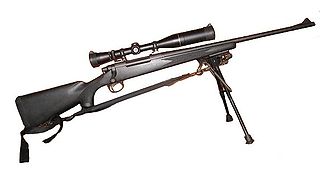
The Remington Model 700 is a series of bolt-action centerfire rifles manufactured by Remington Arms since 1962. It is a development of the Remington 721 and 722 series of rifles, which were introduced in 1948. The M24 and M40 military sniper rifles, used by the US Army and Marine Corps, respectively, are both based on the Model 700 design.
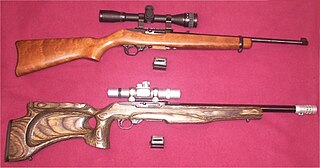
Accurizing is the process of improving the accuracy and precision of a gun.

The lock of a firearm is the mechanism used to initiate firing. It is generally used as a historical term, referring to such mechanisms used in muzzle-loading and early breech-loading firearms, as modern firearms uniformly fire by use of a firing pin to strike the rear of a cartridge. Side-lock refers to the type of construction, in which the individual components of the mechanism are mounted either side of a single plate. The assembly is then mounted to the stock on the side of the firearm. In modern firearm designs, the mechanism to initiate firing is generally constructed within the frame or receiver of the firearm and is referred to as the firing or trigger mechanism.
The Kammerlader, or "chamber loader", was the first Norwegian breech-loading rifle, and among the first breech loaders adopted for use by an armed force anywhere in the world. A single-shot black-powder rifle, the kammerlader was operated with a crank mounted on the side of the receiver. This made it much quicker and easier to load than the weapons previously used. Kammerladers quickly gained a reputation for being fast and accurate rifles, and would have been a deadly weapon against massed ranks of infantry.
Thompson/Center Arms is an American firearms company based in Rochester, New Hampshire. The company was best known for its line of interchangeable-barrel, single-shot pistols and rifles. Thompson/Center also manufactures muzzle-loading rifles and was credited with creating the resurgence of their use in the 1970s.
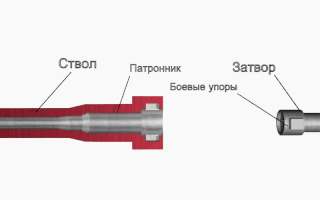
A slamfire is a discharge of a firearm occurring as a cartridge is being loaded into the chamber. Some firearms are designed to slamfire, but the term also describes a malfunction of self-loading firearms. Shooters accustomed to firearms requiring trigger activation for discharge may be unprepared for a slamfire discharge.
The following are terms related to firearms and ammunition topics.
A firearm malfunction is the failure of a firearm to operate as intended for causes other than user error. Malfunctions range from temporary and relatively safe situations, such as a casing that did not eject, to potentially dangerous occurrences that may permanently damage the gun and cause injury or death. Improper handling of certain types of malfunctions can be very dangerous. Following gun safety rules can prevent firearm malfunctions, and limit the damage inflicted by them if they do occur. Proper cleaning and maintenance of a firearm play a big role in preventing malfunctions.

A varmint rifle is a small-caliber precision firearm or high-powered airgun primarily used for both varmint hunting and pest control. These tasks include killing three types of pests or nuisance animals that spread diseases or destroy crops or livestock:
In firearms and artillery, the primer is the chemical and/or device responsible for initiating the propellant combustion that will propel the projectiles out of the gun barrel.

Anschütz 1827 Fortner is a straight-pull action biathlon rifle designed by Peter Fortner junior and produced in cooperation with J. G. Anschütz. The rifle has been dominant in the sport of biathlon since the late 1980s, and is the current sport standard. It is estimated to be used by 97% of biathlon competitors worldwide. About 7000 had been manufactured by 2007.
















